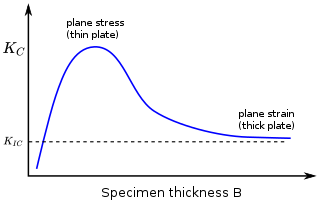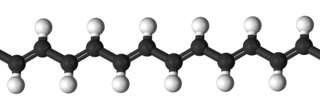Toughening mechanisms

![This is a cartoon representation of failure mechanisms in epoxy resins. The numbers correspond to the following. "(1) shear band formation, (2) fracture of rubber particles, (3) stretching, (4) debonding and (5) tearing of rubber particles, (6) transparticle fracture, (7) debonding of hard particles, (8) crack deflection by hard particles, (9) cavitated rubber particles, (10) crazing, (11) craze tip plastic deformation, (12) diffuse shear yielding, and (13) shear band/craze interaction [19]." Toughening Mechanism in Epoxies.png](http://upload.wikimedia.org/wikipedia/commons/thumb/7/7c/Toughening_Mechanism_in_Epoxies.png/298px-Toughening_Mechanism_in_Epoxies.png)
Different theories describe how a dispersed rubber phase toughens a polymeric substance; most employ methods of dissipating energy throughout the matrix. These theories include: microcrack theory, shear-yielding theory, multiple-crazing theory, shear band and crazing interaction theory, and more recently those including the effects of critical ligament thickness, critical plastic area, voiding and cavitation, damage competition and others. [5]
Microcrack theory
In 1956, the microcrack theory became the first to explain the toughening effect of a dispersed rubber phase in a polymer. [5] Two key observations that went into the initial theory and subsequent expansion were as follows: (1) microcracks form voids over which styrene-butadiene copolymer fibrils form to prevent propagation, and (2) energy stored during elongation of toughened epoxies is released upon breaking of rubber particles. The theory concluded that the combined energy to initiate microcracks and the energy to break rubber particles could account for the increased energy absorption of toughened polymers. This theory was limited, only accounting for a small fraction of the observed increase in fracture energy. [6]
Matrix crazing
The matrix crazing theory focuses on explaining the toughening effects of crazing. Crazes start at the equator where principal strain is highest, propagate perpendicular to the stress, and end when they meet another particle. Crazes with perpendicular fibrils can eventually become a crack if the fibrils break. The volume expansion associated with small crazes distributed through a large volume compared to the small volume of a few large cracks in untoughened polymer accounts for a large fraction of the increase in fracture energy. [6]
Interaction between rubber particles and crazes puts elongation pressures onto the particles in the direction of stress. If this force overcomes the surface adhesion between the rubber and polymer, debonding will occur, thereby diminishing the toughening effect associated with crazing. If the particle is harder, it will be less able to deform, and thus debonding occurs under less stress. This is one reason why dispersed rubbers, below their own glass transition temperature, do not toughen plastics effectively. [6]
Shear yielding
Shear yielding theory is one that, like matrix crazing, can account for a large fraction of the increase in energy absorption of a toughened polymer. Evidence of shear yielding in a toughened polymer can be seen where there is "necking, drawing or orientation hardening." [6] Shear yielding will result if rubber particles act as stress concentrators and initiate volume-expansion through crazing, debonding and cavitation, to halt the formation of cracks. Overlapping stress fields from one particle to its neighbor will contribute to a growing shear-yielding region. The closer the particles are the more overlap and the larger shear-yielding region. [5] Shear yielding is an energy absorbing process in itself, but furthermore initiation of shear bands also aids in craze arrest. The occurrence of cavitation is important to shear yielding theory because it acts to lower the yield stress. Cavitation precedes shear yielding, however shear yielding accounts for a much larger increase in toughness than does the cavitation itself. [6]
Cavitation

Cavitation is common in epoxy resins and other craze resistant toughened polymers, and is prerequisite to shearing in Izod impact strength testing. [10] During the deformation and fracture of a toughened polymer, cavitation of the strained rubber particles occurs in crazing-prone and non-crazing-prone plastics, including, ABS, PVC, nylon, high impact polystyrene, and CTBN toughened epoxies. Engineers use an energy-balance approach to model how particle size and rubber modulus factors influence material toughness. Both particle size and modulus show positive correlation with brittle-tough transition temperatures. They are both shown to affect the cavitation process occurring at the crack tip process zone early in deformation, preceding large-scale crazing and shear yielding. [10] [11]
In order to show increased toughness under strain, the volumetric strain must overcome the energy of void formation as modeled by the equation:
"where and are the shear modulus and bulk modulus of the rubber, is the volume strain in the rubber particle, is the surface energy of the rubber phase, and the function is dependent on the failure strain of the rubber under biaxial stretching conditions." [11]
The energy-balancing model applies the physical properties of the whole material to describe the microscopic behavior during triaxial stress. The volume stress and particle radius conditions for cavitation can be calculated, giving the theoretical minimum particle radius for cavitation, useful for practical applications in rubber toughening. Typically cavitation will occur when the average stress on the rubber particles is between 10 and 20 megapascal. The volume strain on the particle is relieved and voiding occurs. The energy absorption due to this increase in volume is theoretically negligible. Instead, it is the consequent shear band formation that accounts for increased toughness. Before debonding, as the strain increases, the rubber phases is forced to stretch further strengthening the matrix. Debonding between the matrix and the rubber reduces the toughness, creating the need for strong adhesion between the polymer and rubber phases. [10] [11]
Damage competition theory
The damage competition theory models the relative contributions of shear yielding and craze failure, when both are present. there are two main assumptions: crazing, microcracks, and cavitation dominate in brittle systems, and shearing dominates in the ductile systems. Systems that are in between brittle and ductile will show a combination of these. The damage competition theory defines the brittle-ductile transition as the point at which the opposite mechanism (shear or yield damage) appears in a system dominated by the other mechanism. [5]
Characterization of failure
The dominant failure mechanism can usually be observed directly using TEM, SEM and light microscopy. If cavitation or crazing is dominant, tensile dilatometry (see dilatometer ) can be used to measure the extent of the mechanism by measuring volume strain. However, if multiple dilatational mechanisms are present, it is difficult to measure the separate contributions. Shear yielding is a constant volume process and cannot be measured with tensile dilatometry. [6] Voiding can be seen with optical microscopy, however one of two methods, using polarized light or low angle light scattering are necessary to observe the connection between cavitation and shear bands. [10]






























